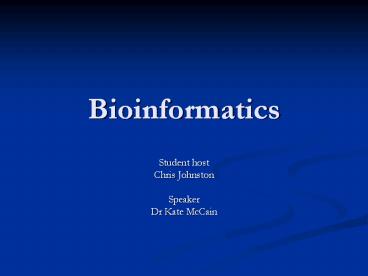Bioinformatics - PowerPoint PPT Presentation
Title:
Bioinformatics
Description:
Title: Bioinformatics Author: Chris Johnston Last modified by: Chris Johnston Created Date: 4/17/2006 12:15:32 AM Document presentation format: On-screen Show – PowerPoint PPT presentation
Number of Views:108
Avg rating:3.0/5.0
Title: Bioinformatics
1
Bioinformatics
- Student host
- Chris Johnston
- Speaker
- Dr Kate McCain
2
Molecular Biology and Biological Chemistry
- Genetic Material
- DNA organize inanimate molecules into functioning
living cells
- Nucleotides
- Four bases in DNA molecule
- GATC
- Genes are many thousand nucleotides long
3
Central Dogma
- Transcription Translation
- DNA RNA Protein
- RNA polymerase Ribosome
- Proteins do all the work
- Catalysts called Enzymes
4
Gene Structure and Information content
- DNA has been the same for billions of years
- Use of Energy is important
- Promoter Sequence
- Positive regulation
- Allow transcription
- Negative regulation
- Prevent transcription
5
The Genetic Code
- Nucleotides information storage and transfer (DNA
RNA) - Amino Acids Make proteins that do work
- Degeneracy genetic code robust hard for
nucleotide to change function of protein it
encodes
6
Protein Structure and Function
- 20 amino acids
- Protein Chain
- Starts at Amino group amino terminus
- Ends at Carboxylic acid group carboxy terminus
- Native Structure complex globular structure
- Amino acids determine shape
- Shape helps perform role
7
Molecular Biology Tools
- Restriction Enzyme Digest
- Enzymes that break double strands used like
scissors later pasted to DNA to isolate given
nucleotides - Restriction mapping
- Cloning
- insert DNA into vectors and replicate to get
large numbers
8
Molecular Biology Tools
- Gel electrophoresis
- Uses electrodes to separate molecules by size.
- Blotting and Hybridization
- Looking for one or more fragments
- Probes used to find unique piece
9
Genomics and Impact
- Genome Organisms complete set of DNA
- Chromosomes
- 24
- Genes made up of 50 to 250 million base pairs
- Proteins perform the work
- 20 amino acids
- 3D structure defines function in cell
10
Human Genome Project
- DNA sequence consists of 3 billion base pairs
- Will guide research and discovery for years
- Find out how cells-genes-proteins work to create
living organisms
11
Medicine and the New Genetics
- Genetic Testing
- Confirm or predict risk of disease
- Prognosticate disease path
- Detecting mutations
- Pharmacogenomics
- Drugs for a genotype
- Minimal side effects
- Work faster
- Cheaper cost to develop
- Faster to develop
12
Other Benefits
- Molecular Medicine
- Microbial Genomics
- Risk assessment
- Bioarchaeology, Anthropology, Evolution, and
Human migration - DNA identification
- Agriculture, Livestock breeding, and
Bioprocessing
13
Resources form the NCBI
- National Center for Biotechnology Information
- Infrastructure for Molecular Biology research
- Diverse Data a challenge
- Sequence Data needs to be used for analysis and
retrieval
14
GenBank
- DNA sequence Database
- 133,000 sequences form species other than human
- Protein sequence
15
GenBank
- Building GenBank
- DNA sequence given unique corresponding Accession
number - When sequence changed gi number given to new
sequence - BLAST algorithms screen for contaminated unwanted
erroneous sequence data
16
GenBank
- BankIt and Sequin
- Submission tools to build GenBank
17
RefSeq
- Reference Sequence
- Aims to nonredundant source of sequence data
- Gene characterization
- Mutation analysis
- Expression studies
- Polymorphism discovery
- Submitted data gets organized
18
Entrez
- Integrated access and retrieval system
- Links many resources to help Scientists find what
they need - Significant innovation for Bioinformatics
19
BLAST
- Family of sequence comparisons algorithms
- Nucleotides and protein sequences understood by
comparison to one another - Type in sequence and BLAST finds similar in the
Entrez system































